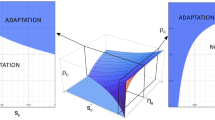Abstract
A new model of the interactions between genotype and phenotype is presented. These interactions are underlied by the activity of the cell regulation network. This network is modeled by a continuous recurrent automata network, which describes both direct and indirect interactions between proteins. To mimic evolutionary processes, a particular genetic algorithm is used to simulate the environmental influences on the interactions between proteins. The fitness function is designed to select systems that are robust to transient environmental perturbations, thus exhibiting homeostasy, and that respond in an adapted way to lasting perturbations by a radical change in their behavior. We show that by evaluating the phenotypic response of the system, one can select networks that exhibit interesting dynamical properties, which allows to consider a biological system from a global prospect, taking into account its structure, its behavior and its ontogenetic development. This model provides a new biological metaphor in which the cell is considered as a cybernetic system that can be programmed using a genetic algorithm.
Preview
Unable to display preview. Download preview PDF.
Similar content being viewed by others
References
R.C. Paton, H.S. Nwana, M.J.R. Shave, T.J.M. Bench-Capon and S. Hughes: Transfer of Natural Metaphors to Parallel Problem Solving Applications. In: Schwefel H.P, Männer R (eds.): Parallel Problem Solving from Nature I, Berlin: Springer-Verlag 1990, pp. 363–372
H.A. Simon: Architecture of complexity, Proc.Am.Philo.Soc. 106, 467–482 (1962)
S. Forrest: Emergent computation: self-organizing, collective, and cooperative phenomena in natural and artificial computing networks. In: Forrest S. (ed.): Emergent Computation, Cambrige: MIT Press 1991: pp. 1–12
Z. Agur and M. Kerszberg: The emergence of phenotypic novelties through progressive genetic change, American Naturalist 129, 6, 862–875 (1987)
S.A. Kauffman: Requirement for evolvability in complex systems, orderly dynamics and frozen components, Physica D 42, 135–152 (1990)
S.A. Kauffman: Principles of adaptation in complex systems. In: Stein D. (ed.): Lectures in the science of complexity, 1, New York:Addison-Wesley 1989, pp. 619–712
M. Huynen and P. Hogeweg: Genetic algorithms and information accumulation during the evolution of gene regulation. In: Schaffer J.D. (ed.): Proceeding of the Third International Conference on Genetic Algorithms, San Mateo, CA: Morgan Kauffman 1989, pp. 225–230
R.K. Belew, J. McInerney and N.N. Schraudolph: Evolving networks: using the genetic algorithm with connectionist learning. In: C.G Langton, C. Taylor,J.D.Farmer,S.Rasmussen (eds.): Artificial Life II, New York: Addison-Wesley 1992, pp. 511–547
J.J. Hopfield: Neural networks and physical systems with emergent collective computational abilities,Proc.Natl.Acad.Sci.USA 79, 2554–2558 (1982)
M.H. Hassoun: Dynamic associative memories, In: Sethi I.K. and Jain A.K. (eds.): Artificial Neural Networks and Statistical Pattern Recognition, Old and New Connections, Amsterdam: North-Holland 1991, pp. 195–218
D.E. Goldberg: Genetic algorithms in search, optimization and machine learning, Addison-Wesley, Reading, MA (1989).
G. Syswerda: Uniform crossover in genetic algorithms. In: Schaffer J.D. (ed.): Proceeding of the Third International Conference on Genetic Algorithms, San Mateo, CA.: Morgan Kauffman 1989, pp. 2–9
G.F.Miller,P.M.Todd and S.U.Hegde: Designing neural networks using genetic algorithms. In: Schaffer J.D. (ed.): Proceeding of the Third International Conference on Genetic Algorithms, San Mateo, CA: Morgan Kauffman 1989, pp. 379–384
H.Kitano: Designing neural networks using genetic algorithms with graph generation system. Complex Systems 4: 461–476 (1992)
F. Gruau: Genetic synthesis of modular neural networks. In: Forrest S. (ed.): Proceeding of the Fifth International Conference on Genetic Algorithms, San Mateo, CA.: Morgan Kauffman 1993: pp. 318–325
S. Fahlman and C. Lebiere: The Cascade-Correlation Learning Architecture, Tech.Rep.CMU-CS-90-100 (1990)
H. Jacobson: Information, reproduction and the origin of life, American Scientist 43, 119–127 (1955)
B. Derrida and D. Stauffer: Phase-transitions in two-dimensional Kauffman cellular automata, Europhys.Lett. 2, 739–745 (1986)
G. Weisbuch and D. Stauffer: Phase transition in cellular random Boolean nets,J.Phys 48, 11–18 (1987)
C.G. Langton: Computation at the edge of chaos, phase transitions and emergent computation,Physica D 42, 12–37 (1990)
R.J.Bagley,J.D.Farmer,S.A.Kauffman,N.H.Packard,A.S.Perelson and I.M.Stadnyk: Modeling adaptive biological systems, BioSystems 23, 113–138 (1989)
Author information
Authors and Affiliations
Editor information
Rights and permissions
Copyright information
© 1994 Springer-Verlag Berlin Heidelberg
About this paper
Cite this paper
Chiva, E., Tarroux, P. (1994). Studying genotype-phenotype interactions: A model of the evolution of the cell regulation network. In: Davidor, Y., Schwefel, HP., Männer, R. (eds) Parallel Problem Solving from Nature — PPSN III. PPSN 1994. Lecture Notes in Computer Science, vol 866. Springer, Berlin, Heidelberg. https://doi.org/10.1007/3-540-58484-6_247
Download citation
DOI: https://doi.org/10.1007/3-540-58484-6_247
Published:
Publisher Name: Springer, Berlin, Heidelberg
Print ISBN: 978-3-540-58484-1
Online ISBN: 978-3-540-49001-2
eBook Packages: Springer Book Archive




